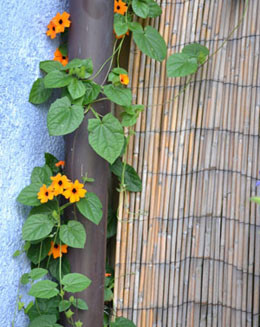If it is a beautiful hanging basket or a twining ground cover you want full of a bright display, then a Black-eyed Susan vine is the perfect option for you. Read on to know more about this vine.

The scientific name of Black-eyed Susan vine is
Thunbergia alata. It was named thus in 1780 by Anders Retzius, a Swedish professor of anatomy, in honor of Carl Peter Thunberg, a Swedish botanist, doctor, explorer, and author. This herbaceous perennial climber is native to Eastern Africa, and because of its vibrant colors, it is now famous the world over. It is often confused with
Rudbeckia hirta, also known as Black Eyed Susan. Although they both belong to the same flowering plant family
Asteraceae, the Black-eyed Susan vine, as the name suggest is a creeper, whereas the Black Eyed Susan is a plant with branched-out stems. It is perennial in nature, and flowers throughout the year if given the right conditions.
The vine can grow 6-8 feet in height when in wild, and much less when grown in containers. The leaves are heart or arrow-shaped, and are slightly rough because of the microscopic hair on them. The vine bears flowers in spring, summer, early autumn/fall, and even in winters if the climate is conducive. These flowers are soft five-petaled blooms, arranged in a circular symmetrical order, with dark, almost black centers, hence the name. The colors range from yellow/orange to cream/white.
How to Grow Black-eyed Susan Vines
This ornamental vine is propagated through seeds and cuttings. As the seeds are large, they can be directly sown in the intended location. The vine often gets damaged while it is being transplanted, just as most ornamental vines do. One can grow them in Styrofoam cups too. Prepare the soil mix by adding one part soil, one part compost, and some perlite to facilitate easy drainage. The soil should be porous, whether in the ground, in pots, in hanging baskets, or in Styrofoam cups. Sow individual seeds one-quarter inch deep in the soil, and cover it lightly. Water it well, and leave it out in partial sunlight to sprout. Cover the ground bed with a newspaper. The seeds will germinate within 10 to 15 days at 70°F even without cover, as long as the soil is kept moist. For propagating through cuttings, cut a strong and old stem about 10-15 inches in length, dip it in some rooting hormone, and stick it gently in a commercial soil mix. One can even collect stems that have sprouted roots by coming in contact with soil. Cuttings can also be rooted through water.
Black-eyed Susan Vine Care
Following are the tips to keep in mind while caring for this vine:
- If seeds are sown where the vine is to grow and bloom, then make sure you space them out well, about three inches apart. The number of seedlings to be transplanted in pots and hanging baskets should be according to their sizes.
- This vine needs full sunlight, although not hot and direct. Adequate light brings out the brightness in the color of its flowers.
- Water regularly and adequately, as the vine is very vulnerable to root rot. Less water will kill the vine. If your plant has wilted away, then immediately stand the entire container in a tub of water. Once the vine starts to bear buds, feed it with water-soluble fertilizer weekly to keep the blooms coming through the end of the flowering season.
- Spider mites, whiteflies, and scale insects are generally the pests and diseases that infest this vine. A regular germicide spray takes care of it though.
- A regular pruning which includes pinching, thinning, and shearing damaged twiners can be done to boost the vine for a prolonged bloom.
This vine can be grown to cover posts, porches, or fences. One can trail them down from baskets or pots close to sunny windows, cover the ground with them, or creep them up on a trellis. No matter where you grow these, they will never fail to cheer up your mood.






 The scientific name of Black-eyed Susan vine is Thunbergia alata. It was named thus in 1780 by Anders Retzius, a Swedish professor of anatomy, in honor of Carl Peter Thunberg, a Swedish botanist, doctor, explorer, and author. This herbaceous perennial climber is native to Eastern Africa, and because of its vibrant colors, it is now famous the world over. It is often confused with Rudbeckia hirta, also known as Black Eyed Susan. Although they both belong to the same flowering plant family Asteraceae, the Black-eyed Susan vine, as the name suggest is a creeper, whereas the Black Eyed Susan is a plant with branched-out stems. It is perennial in nature, and flowers throughout the year if given the right conditions.
The scientific name of Black-eyed Susan vine is Thunbergia alata. It was named thus in 1780 by Anders Retzius, a Swedish professor of anatomy, in honor of Carl Peter Thunberg, a Swedish botanist, doctor, explorer, and author. This herbaceous perennial climber is native to Eastern Africa, and because of its vibrant colors, it is now famous the world over. It is often confused with Rudbeckia hirta, also known as Black Eyed Susan. Although they both belong to the same flowering plant family Asteraceae, the Black-eyed Susan vine, as the name suggest is a creeper, whereas the Black Eyed Susan is a plant with branched-out stems. It is perennial in nature, and flowers throughout the year if given the right conditions.